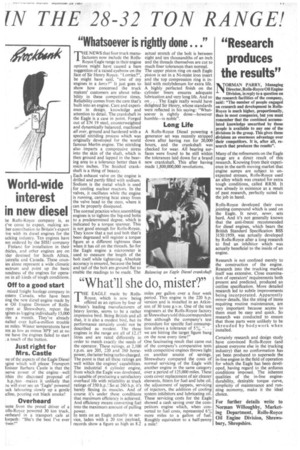"Whatsoever is rightly done. . ."
Page 13

If you've noticed an error in this article please click here to report it so we can fix it.
THE NEWS that four truck manufacturers now include the RollsRoyce Eagle range in their engine options might have caused a bare suggestion of a raised eyebrow on the face of Sir Henry Royce. "Lorries?", he might have said, "one of my engines in a lorry?" It just goes to show how concerned the truck makers' customers are about reliability in these competitive times. Reliability comes from the care that's built into an engine. Care and experience in design, knowledge and attention to detail. The crankshaft in the Eagle is a case in point. Forged out of EN 19 steel, counterweighted and dynamically balanced, machined all over, ground and hardened with a special nitriding process which was originally developed for the world famous Merlin engine. The nitriding also imparts a compressive stress into the skin of the shaft, which is then ground and lapped in the bearing area to a tolerance better than 6 micro inches. The finished crankshaft is a thing of beauty.
Each exhaust valve on the engine is drilled and partly filled with sodium. Sodium is the metal which is used for cooling nuclear reactors. In the valves, it oscillates while the engine is running, carrying heat away from the valve head to the stem, where it can be properly dissipated.
The normal practice when assembling engines is to tighten the big-end bolts to a predetermined degree, which is indicated by a torque spanner. This is not .good enough for Rolls-Royce. They know that a nut and bolt that's been degreased will register a torque figure at a different tightness than when it has oil on the threads. So for the Eagle engine a micrometer is used to measure the length of the bolt itself while tightening. Absolute accuracy is ensured, because the head and tail of the bolt are ground flat to enable the readings to be made. The actual stretch of the bolt is between eight and ten thousandths of an inch and the threads themselves are cut to much finer tolerances than normal. The upper piston ring on each Eagle piston is set in a Ni-resist iron insert and the top compression ring is inlaid with molybdenum for extra life. A highly perfected finish on the cylinder liners ensures adequate lubrication and very long life. And so on. . . The Eagle really would have delighted Sir Henry, whose standards were reflected in his saying: "Whatsoever is rightly done—however humble—is noble".
Long Life
A Rolls-Royce Diesel powering a generator set was recently stripped down after having run for 20,000 hours, and the crankshaft was checked for wear. All bearing surfaces were found to be still within the tolerances laid down for a brand new crankshaft. This after having made 1,800,000,000 revolutions.




































































































































































